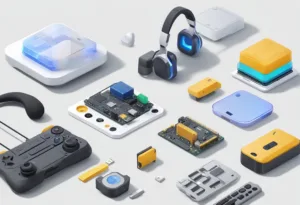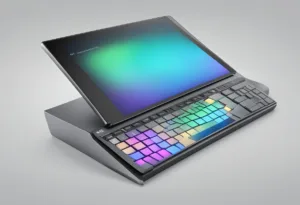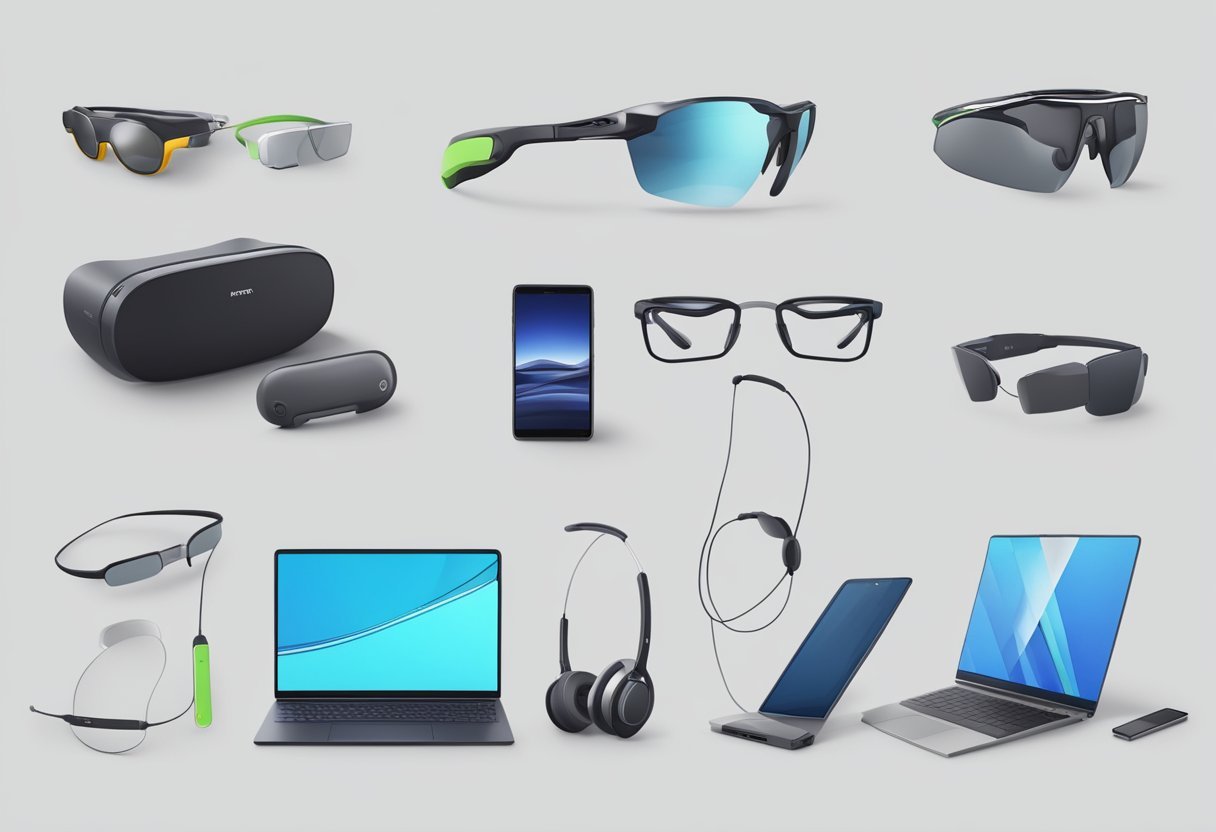Dive headfirst into the enthralling universe of AR Hardware Devices, a realm where the fabric of reality is interwoven with the threads of the digital world, creating a tapestry of experiences that are as rich and dynamic as they are interactive. In this blog post, we’re set to unravel the myriad of devices that serve as the backbone of Augmented Reality; a technology that’s not just changing the game but redefining the very way we perceive and interact with our environment.
From the everyday accessibility of AR-enabled smartphones to the specialized sophistication of headsets and glasses, these devices are the conduits through which the virtual becomes tangible. We’ll explore how cutting-edge advancements like AR contact lenses and projection-based systems are edging us closer to a future where the lines between the physical and the digital blur into obscurity.
Evolution of AR Hardware
AR technology has come a long way since the early days of Google Glass. The first iteration of the device was released in 2013, and while it generated a lot of buzz, it ultimately failed to gain traction due to its high price point and limited functionality. However, Google Glass paved the way for the development of more advanced AR hardware, such as Magic Leap.
Magic Leap is a mixed reality headset that uses a combination of sensors, cameras, and projectors to create a seamless AR experience. The device is designed to be worn for extended periods of time, and features a high-resolution display that can project virtual objects onto the real world with stunning clarity. While Magic Leap is still a relatively new technology, it has already gained a lot of attention from developers and consumers alike.
Advancements in Display Technology
One of the key drivers behind the evolution of AR hardware has been advancements in display technology. In the early days of AR, devices like Google Glass used small displays that were mounted in front of the user’s eye. While these displays were effective at overlaying virtual objects onto the real world, they were limited in terms of resolution and field of view.
Today, however, AR devices like Magic Leap use much more advanced displays that are capable of projecting high-resolution virtual objects onto the real world with a wide field of view. These displays use a combination of projectors and sensors to track the user’s movements and adjust the virtual objects accordingly, creating a seamless AR experience.
The Rise of AR in Everyday Life
As AR hardware has become more advanced and more affordable, it has started to gain traction in everyday life. Today, AR is being used in a wide range of applications, from gaming and entertainment to education and healthcare.
For example, AR is being used in the healthcare industry to help doctors and nurses visualize complex medical procedures and diagnose illnesses more accurately. In education, AR is being used to create immersive learning experiences that help students better understand complex concepts. And in gaming, AR is being used to create new and exciting gaming experiences that blur the line between the real world and the virtual world.
The evolution of AR hardware has been driven by a combination of technological advancements and changing consumer needs. As AR continues to gain traction in everyday life, it is likely that we will see even more advanced AR hardware in the years to come.
Top 10 AR Hardware Devices

- Smartphones and Tablets
- Smart Glasses
- AR Headsets
- AR Contact Lenses
- Virtual Retinal Displays
- AR Helmets
- Holographic Displays
- Wearable AR Devices
- Handheld AR Devices
- Projection-Based AR Systems
Smartphones and Tablets
Smartphones and tablets are the most common and accessible forms of AR hardware. They work by using their built-in cameras to capture the real world and their screens to overlay digital information onto the camera feed. The device’s processor runs AR software that recognizes images, objects, or spatial information, and the AR application then renders 3D models, animations, or information in real-time. The device’s sensors, such as gyroscopes and accelerometers, track movement and orientation to ensure the digital content aligns correctly with the physical world.
Smart Glasses
Smart glasses are wearable AR devices that project digital information onto the user’s field of view. They typically include a small display, camera, and sensors integrated into the frame of the glasses. The display reflects light into the user’s eyes, creating the illusion of images floating in their natural environment.
Smart glasses rely on a combination of motion sensors, GPS, and sometimes external cameras to provide contextually relevant information based on what the user is looking at, enhancing the user’s reality without obstructing their vision.
AR Headsets
AR headsets are devices worn on the head that provide a more immersive AR experience than smart glasses. They have transparent lenses that allow users to see the real world while digital content is projected onto the lenses, creating a mixed reality.
These headsets often include advanced sensors, cameras, and sometimes depth sensors to accurately map the environment and understand the user’s spatial context. This allows for precise placement and interaction with digital objects as if they are part of the real world.
AR Contact Lenses
AR contact lenses are an emerging technology that aims to embed AR directly into contact lenses worn on the eye. These lenses are designed to project images and information directly onto the wearer’s retina. They work by using micro-LEDs or a similar technology to display content in the user’s line of sight, potentially offering a more seamless and unobtrusive AR experience. While still in the developmental stage, these lenses would need to incorporate miniature batteries and wireless technology to receive data from an external device.
Virtual Retinal Displays
Virtual retinal displays (VRD) work by projecting a laser or LED light source directly onto the retina, creating images that are perceived by the user without the need for screens or external displays. This technology bypasses traditional display methods, offering potentially sharper and more vivid images.
VRDs use low-power laser diodes and a combination of optics and micro-mirrors to scan the light onto the retina, drawing the image pixel by pixel. This can create the sensation of viewing a large display at some distance from the user.
AR Helmets
AR helmets are similar to headsets but are often designed for more specialized, professional uses, such as construction or manufacturing. These helmets not only provide AR visualizations but also offer physical protection. They are equipped with see-through visors or displays, cameras, and environmental sensors that overlay digital information onto the real world, aiding in tasks such as assembly, repair, or navigation through complex environments.
Holographic Displays
Holographic displays create three-dimensional images that can be viewed without special glasses, often using light diffraction techniques. These displays use holograms to produce light fields that replicate how we perceive light in the real world, which means the digital objects appear to exist in three-dimensional space. This technology is typically used in static installations, such as advertising displays or interactive signs, where users can move around and see the holographic image from different angles.
Wearable AR Devices
Wearable AR devices go beyond glasses and helmets, encompassing any wearables that integrate AR technology. This could include watches, wristbands, or clothing that interacts with an AR application. These devices use sensors to track movement and orientation, and they often communicate with a smartphone or tablet to display information in the user’s field of view through a connected AR app.
Handheld AR Devices
Handheld AR devices are specialized devices designed solely for AR interactions. Unlike smartphones and tablets, these are often purpose-built for specific applications, such as industrial design or medical training. They typically include a display, camera, and sensors, and they may have specialized software that allows for more precise or industry-specific AR applications.
Projection-Based AR Systems
Projection-based AR systems work by projecting synthetic light onto physical surfaces, and the interactions are detected by sensors or cameras. These systems can turn any surface into an interactive display, where the real-world environment becomes a canvas for digital content. This type of AR can be used for interactive marketing displays, collaborative workspaces, or educational purposes, where users can manipulate the projected content as if it were a touchscreen.
Key AR Hardware Components

Augmented Reality (AR) hardware is the foundation of AR technology. It is the hardware that enables the user to experience the digital world in a real-world environment. The main components of AR hardware include sensors, optics and display units, computing power, and memory.
Sensors and Machine Learning
Sensors are the core components of AR hardware. They provide the necessary data for machine learning algorithms to create a virtual representation of the real world. The sensors used in AR hardware include cameras, accelerometers, gyroscopes, and GPS. The data collected by these sensors is processed by machine learning algorithms to create a digital model of the environment.
Optics and Display Units
Optics and display units are the components that enable the user to see the virtual world. They are responsible for projecting the digital information onto the real world. The quality of optics and display units determines the quality of the AR experience. The display units used in AR hardware include LCD, OLED, and microLED displays. The optics used in AR hardware include waveguides, mirrors, and lenses.
Computing Power and Memory
Computing power and memory are the components that enable AR hardware to process data and create a virtual representation of the real world. The computing power and memory of AR hardware vary depending on the device. The computing power of AR hardware is measured in terms of CPU and GPU performance. The memory of AR hardware is measured in terms of RAM and storage capacity.
AR hardware is constantly evolving, and new components are being developed to improve the AR experience. The quality of AR hardware is essential to the success of AR technology. As the demand for AR hardware increases, manufacturers are investing more resources in developing high-quality AR hardware.
Leading AR Devices and Platforms

Microsoft HoloLens and Mixed Reality
Microsoft HoloLens is a mixed reality headset that allows users to interact with holograms in the real world. The device has been designed for enterprise use, and it has become a popular tool for businesses looking to enhance their operations.
The HoloLens has a range of features that make it an attractive option for businesses, including spatial mapping, hand gesture recognition, and voice recognition. The device has been used in a variety of industries, including manufacturing, healthcare, and education.
Mixed Reality is a term coined by Microsoft to describe a combination of Virtual Reality (VR) and Augmented Reality (AR). The HoloLens is a Mixed Reality device that allows users to interact with both virtual and real-world objects. This makes it an ideal tool for businesses looking to enhance their operations with the latest technology.
Meta Quest and the Metaverse
Meta Quest is a virtual reality headset that has been designed for gaming. The device has been developed by Oculus, a subsidiary of Facebook, and it has become a popular tool for gamers looking to immerse themselves in a virtual world. The device has a range of features that make it an attractive option for gamers, including hand gesture recognition, voice recognition, and positional tracking.
The Metaverse is a term used to describe a virtual world that is created by the convergence of multiple virtual and physical environments. Meta Quest is an important tool in the development of the Metaverse, as it allows users to immerse themselves in a virtual world and interact with other users in real-time.
Apple and Google’s Contributions
Apple and Google are two of the biggest players in the tech industry, and they have both made significant contributions to the development of AR technology. Apple’s ARKit is a software development kit that allows developers to create AR applications for iOS devices. The platform has been used to create a range of AR applications, including games, educational apps, and business tools.
Google’s ARCore is a similar platform that allows developers to create AR applications for Android devices. The platform has been used to create a range of AR applications, including games, educational apps, and business tools. Both platforms have been instrumental in the development of AR technology, and they have helped to make AR more accessible to developers and users alike.
AR User Experience and Interface Design

When it comes to AR hardware, the user experience and interface design play a crucial role in the success of the product. The following subsections will discuss some important aspects of user experience and interface design in AR hardware.
AR Glasses and Smart Glasses
AR glasses and smart glasses are becoming increasingly popular in the market due to their ability to provide users with an immersive experience. The user interface design of these glasses should be intuitive and easy to use to ensure a positive user experience. The glasses should also be comfortable to wear for extended periods of time.
Software Integration and AR Apps
The integration of software and AR apps is an important aspect of user experience in AR hardware. The software should be designed to seamlessly integrate with the hardware to provide a smooth and efficient user experience. AR apps should be designed to enhance the user experience and provide users with an immersive experience.
Real-Time Interaction and Navigation
Real-time interaction and navigation are important aspects of user experience in AR hardware. The hardware should be designed to provide real-time feedback to the user, allowing for a seamless interaction with the environment. Navigation should be intuitive and easy to use, allowing users to move around in the environment without any difficulty.
User experience and interface design are crucial aspects of AR hardware. The AR glasses and smart glasses should be intuitive and easy to use, the software should be seamlessly integrated with the hardware, and real-time interaction and navigation should be a priority.
Adoption Challenges and Considerations
Balancing Performance and Battery Life
One of the main challenges in the adoption of AR hardware is balancing performance and battery life. AR hardware requires a significant amount of processing power to render high-quality graphics and provide a smooth user experience. However, this can be a drain on the battery life of the device, which can limit the amount of time that the user can use the device without needing to recharge it.
To address this challenge, hardware manufacturers need to carefully consider the power requirements of their devices and optimize the hardware and software to minimize power consumption. This can include using more efficient processors, optimizing software algorithms, and using more efficient display technologies.
Hardware Weight and Comfort
Another important consideration in the adoption of AR hardware is the weight and comfort of the device. AR hardware typically needs to be worn on the head, which can be uncomfortable for extended periods of time. The weight of the device can be a limiting factor in terms of the user’s ability to move around freely and comfortably while using the device.
To address this challenge, hardware manufacturers need to carefully consider the ergonomics of their devices and design them to be as lightweight and comfortable as possible. This can include using lightweight materials, optimizing the weight distribution of the device, and providing adjustable straps and padding to ensure a comfortable fit.
Privacy Concerns and Social Acceptance
Finally, privacy concerns and social acceptance are also important considerations in the adoption of AR hardware. AR hardware can be seen as intrusive and may raise concerns about privacy and data security. The use of AR hardware in public spaces may be seen as socially unacceptable or even dangerous.
To address these concerns, hardware manufacturers need to be transparent about the data that their devices collect and how it is used. They also need to design their devices to be as unobtrusive as possible and consider the social norms and expectations of the communities in which their devices will be used.
The adoption of AR hardware presents a number of challenges and considerations that need to be carefully addressed by hardware manufacturers. By balancing performance and battery life, optimizing hardware weight and comfort, and addressing privacy concerns and social acceptance, hardware manufacturers can help to ensure the successful adoption of AR hardware by the wider public.
Frequently Asked Questions

What types of devices are used for augmented reality experiences?
Augmented reality (AR) experiences can be delivered through a variety of devices, including smartphones, tablets, smart glasses, and head-mounted displays (HMDs). Smartphones and tablets are the most common devices used for AR, as they have built-in cameras and can run AR apps. Smart glasses and HMDs are more advanced devices that offer a more immersive AR experience, but they are typically more expensive.
How do augmented reality headsets work?
AR headsets use a combination of sensors, cameras, and displays to create an immersive AR experience. The sensors track the user’s movements and position in space, while the cameras capture the real-world environment. The AR software then overlays virtual objects onto the real-world environment, which are displayed on the headset’s screens.
What are the typical costs associated with purchasing an AR system?
The cost of an AR system can vary widely depending on the type of device, the level of functionality, and the intended use. A basic AR app for a smartphone or tablet may be free or cost a few dollars, while a high-end AR headset can cost several thousand dollars. Additional costs may include software licenses, developer fees, and ongoing maintenance and support.
Can you list some examples of augmented reality hardware currently available?
Some examples of AR hardware currently available include the Microsoft HoloLens 2, the Magic Leap One, the Google Glass Enterprise Edition 2, and the Vuzix Blade. These devices range from high-end AR headsets to more affordable smart glasses and are designed for a variety of industries, including healthcare, manufacturing, and retail.
What are the essential components that make up an augmented reality system?
An AR system typically consists of hardware components, such as cameras, sensors, and displays, as well as software components, such as AR development tools and AR apps. The hardware components capture and display the real-world environment, while the software components enable the creation and display of virtual objects.
In what ways can augmented reality be applied across different industries?
AR has applications in a wide range of industries, including healthcare, education, manufacturing, and entertainment. In healthcare, AR can be used for surgical planning and training, while in education, AR can enhance learning by providing interactive and immersive experiences. In manufacturing, AR can be used for assembly line training and quality control, while in entertainment, AR can be used to create immersive gaming experiences.




